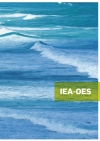


FOREWORD:
2006 was another significant year in Ocean energy development, both from the perspective of device and project development, and from that of the IEA Ocean Energy Systems Implementing Agreement.
From an industry perspective, another five devices have been tested in open seas:
The Pico Plant in Portugal was re-commissioned and is providing grid-connected electricity. A number of devices that have been tested are in the process of planning and building full scale and multi-device projects, including the three device Pelamis project in Portugal funded by Enersis which was undergoing final assembly during the year. Additionally, policy makers are taking a greater interest in ocean energy with a number of countries developing specific policies for ocean energy including New Zealand, Canada, and Korea. All of this interest and activity provided the background for a fruitful year for the IEA OES. Our meetings rooms were larger, to accommodate the growing number of member and observer countries attending, and our side trips were more interesting, as they provided opportunities to see tangible evidence of ocean energy development. Our meetings were also productive as we successfully agreed two new co operative work programmes: the extension of Annex II to consider open sea testing, and Annex III to investigate grid integration issues for ocean energy systems. We were also very pleased to receive a positive response from both the IEA Renewable Energy Working Party and the IEA Committee on Energy Research and Technology to our End of Term Report, reviewing the first five year term of the IEA OES, and our Strategy for 2007 – 2011. Both groups approved the extension of the IEA OES for another five years.